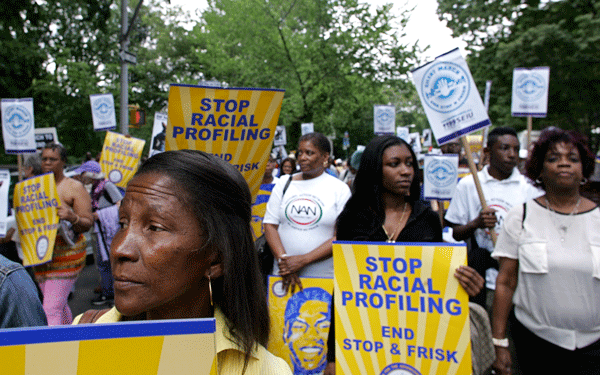
Out of more than 680,000 stop and frisks that occurred citywide in 2011, only about 1,700 happened in Greenwich Village (not including those inside or immediately outside the neighborhood’s PATH stations), according to a data map published by thenewyorkworld.com.
But West Village dwellers don’t have to go far to find a community quite unlike theirs, one they might assume to be part of a different world — or, at least, a very different part of the city.
About 5,500 stop-and-frisk encounters took place last year within the small area surrounding eight public housing developments on the Lower East Side. That’s more than three times as many as in the West Village.
And for the people who call the L.E.S. projects home — those who live, in some cases, only a dozen blocks from several of the city’s most affluent enclaves — feelings of desperation existed long before “stop and frisk” became a media buzzword.
“It’s not fair,” said Shurnetta Thompson, who has lived for 22 years in the Rutgers Houses, a five-building development bordered by Madison, Rutgers, Cherry and Pike Sts. “And it’s gotten even worse here since I first moved in. The people who live here didn’t get any worse, but their experiences with the police certainly have.”
Thompson declined to give her age, but said laughingly that she is old enough to be both a mother and a grandmother. She added that was last stopped and frisked in 2009.
“It’s degrading and humiliating,” said Thompson, “to be my age and to have somebody do that to me.”
While the stop-and-frisk debate has already gotten as far as the federal Justice Department — as well as sparking a massive silent march down Fifth Ave. on Sun., June 17 — Thompson’s most pressing issues remain rather personal. She spends a great deal of time canvassing her neighborhood, attempting to organize a community-based response to police tactics within the projects.
Along with the Rutgers Houses, the most heavily affected area of the L.E.S. also includes the Smith Houses, Baruch Houses, Gompers Houses, Hernandez Houses, LaGuardia Houses, Vladeck Houses and Lower East Side Infill No. 1. It’s a portion of the city mainly populated by African-Americans and Latinos — the two racial minority groups that collectively accounted for 87 percent of all stop-and-frisk incidents last year, according to New York Police Department data.
But even as large advocacy groups like the NAACP and Reverend Al Sharpton’s National Action Network throw their weight behind trying to end stop-and-frisk policies, Thompson says she’s struggled to convince her neighbors to make tangible efforts to join the fight.
She believes that’s because residents of the projects — especially young people — have been so worn down by a negative police presence that many believe they simply can’t do anything about it.
“I have no problem getting them to sign a petition,” said Thompson, “but I just haven’t been able to get anyone to come out and organize. So many of them really think that no matter what we do, there’s not going to be a change.”
Those feelings among the younger generation could be a result of the disproportionate number of stop and frisks targeting people between the ages of 14 and 24. In 2011, slightly more than half of all the reported incidents happened to individuals in that age range.
For young people like 15-year-old Joshua, another Rutgers Houses resident, being stopped and frisked without cause just leads to confusion and frustration and impedes the possibility for positive relations with the police.
“Last time, it was for something stupid, like just standing around outside our building,” he said. “The police didn’t say why it was happening. But they just assume that we have drugs, or stuff like that, on us. When they realize that we don’t, they just say ‘Keep walking,’ or ‘Go home.’ ”
Joshua, who moved to the L.E.S. from the Bronx last year, added that his first stop-and-frisk encounter took place when he was 13.
So when Shurnetta Thompson showed up to the Father’s Day March Against Stop and Frisk last Sunday, she was disappointed — but not surprised — to see that almost none of the people she’d invited from her neighborhood had come. She walked the 30 blocks down Fifth Ave. with pride, surrounded by tens of thousands of like-minded city residents, but the only one she’d actually arrived with was her daughter, Asia Ceasar.
“They want change, but they don’t want to participate,” said Ceasar, 23, when asked about the members of her community who had stayed home.
Once Sunday’s march had finished, Thompson met with her 43-year-old son, Marc, who was walking in a different part of the crowd. When asked about any perceived lack of interest on the part of young people currently growing up in the place where he grew up, he said it has much to do with a generational gap — one that tends to separate today’s potential protesters from the civil rights marchers of the 1960s and ’70s.
“I think some members of the younger generation are not really in tune with the messages of unity spread by Malcolm X and Dr. King,” he said. “They’re also not really reading the newspapers and staying involved in current events, and I think that’s why they don’t feel that they can make a difference.”
But even as struggles to maintain an active dialogue within the L.E.S. projects continue, citywide movement on anti-stop-and-frisk legislation have begun to gain strength.
City Councilmember Margaret Chin, whose district includes the Lower East Side, was one of the many politicians present at the Father’s Day march. She’s also one of more than 20 sponsors of the Community Safety Act, a package of four bills currently in the City Council that seeks to drastically reform the ways in which police officers interact with residents.
Taken together, the bills would ban racial profiling by the N.Y.P.D., prevent officers from pressuring an individual into consenting to an unwarranted search, and require officers to provide their name and their card to anyone being stopped. In addition to those departmental reforms, the most recently introduced piece of the legislative package would instate an inspector general, appointed by the mayor, who could conduct independent reviews of N.Y.P.D. policies.
While she touted the pending legislation, Chin acknowledged that the community-based concerns raised by people like Shurnetta Thompson will remain a challenge to address.
“We need to go back to the street patrolling that I remember in the old days, when I was growing up in Chinatown,” Chin said. “We used to know the police officers in the neighborhood; you could say hello and they’d stop and talk to you.”
“Nowadays,” she added, “officers are always being moved around from precinct to precinct, so it doesn’t allow people to become familiar with them, or to stay engaged.”
As the media’s focus on stop and frisk continues — likely into next year’s mayoral election — the balance of broader civil rights goals and more intimate community action may end up shaping the debate for years to come.
Upon nearing the end of Sunday’s march, Thompson had at least one thing to feel glad about. Even with all the difficulty she’d had trying to organize her neighbors into action, she could now bring back to the Rutgers Houses a clear message from that massive gathering.
“I need to let them know,” she said. “ ‘You
may be roped off in there, but you’re not alone.’ ”
































